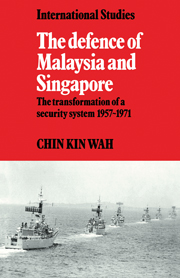Book contents
- Frontmatter
- Contents
- Preface
- Acknowledgements
- List of abbreviations
- Note on currency units
- 1 Introduction
- 2 Pre-treaty defence relations
- 3 Decolonisation and the institution of the defence agreement
- 4 The extension of AMDA
- 5 The external testing of AMDA
- 6 Towards a closing of ranks
- 7 The fractured axis
- 8 Britain weighs anchor
- 9 From AMDA to the five-power defence system
- 10 Conclusions
- Postscript on five-power arrangements
- Notes
- Bibliography
- Index
- Frontmatter
- Contents
- Preface
- Acknowledgements
- List of abbreviations
- Note on currency units
- 1 Introduction
- 2 Pre-treaty defence relations
- 3 Decolonisation and the institution of the defence agreement
- 4 The extension of AMDA
- 5 The external testing of AMDA
- 6 Towards a closing of ranks
- 7 The fractured axis
- 8 Britain weighs anchor
- 9 From AMDA to the five-power defence system
- 10 Conclusions
- Postscript on five-power arrangements
- Notes
- Bibliography
- Index
Summary
As a framework for defence collaboration in the Malaysia–Singapore region, AMDA was bracketed between two distinct phases of intraalliance relations. At the beginning was the loose, informal, ANZAM arrangement which reflected a period of Commonwealth defence collaboration in the Malayan area when Malaya itself was essentially an object of international relations. ANZAM was eventually subsumed within AMDA, which aided Malaya's transition into nationhood. AMDA in turn was superseded by a loose consultative arrangement which resembled ANZAM. AMDA, whose cycle was completed in 1971, thus represented a transitional phase in intraalliance relations.
While intra-alliance relations cannot be wholly understood by reference to AMDA alone, the rise and demise of the treaty were influenced by the process of redefinition of interests among the defence partners. The dismantling of AMDA was the culmination of the treaty's failure to accommodate their increasingly divergent interests. The significant turning points in the course of alliance transformation (from the formation of AMDA to its extension, to its de facto amendment, to the stages of its destructuring) were determined more by intra-alliance developments than by influences stemming from changes in the external environment of the alliance.
AMDA was a unique alliance system. While sharing with other unequal burden treaties the characteristic of a great power acting as anchor for the alliance, AMDA also embraced two associate powers which were ‘consumers’ as well as sub-providers of alliance security.
- Type
- Chapter
- Information
- The Defence of Malaysia and SingaporeThe Transformation of a Security System 1957–1971, pp. 179 - 191Publisher: Cambridge University PressPrint publication year: 1982

